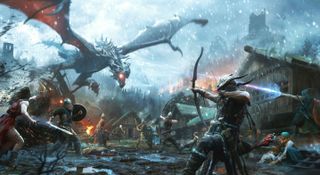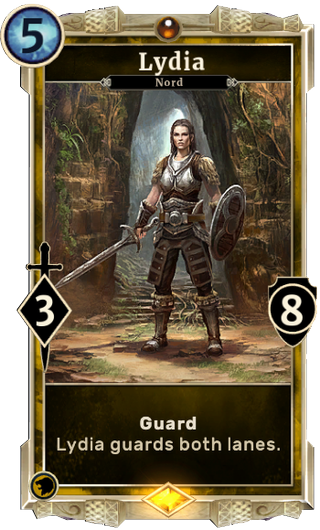
As no-brainers go, they don't come much less brainy than picking Skyrim as the theme for the first full expansion for your Elder Scrolls card game. Not that I blame developer Dire Wolf Digital for pushing for the most obvious button one bit. Until last month, it's fair to say Legends didn't feel in the best health, with a stale meta and long queue times suggesting a slim playerbase. But June saw a series of substantial improvements, starting with the Steam release (previously Legends had only been playable through Bethesda's launcher) and followed by the launch of 'Twitch Drops', which handed players juicy amounts of in-game gold and crafting currency just for watching streamers play the game.
I've written in detail about drops, but the short version is that they've probably saved Legends. The game always felt generous in terms of rewards, especially compared to Hearthstone, but partly that was out of necessity. Legends uses bigger decks (50 cards minimum versus 30 maximum in Hearthstone), and these can include up to three copies of many legendaries, meaning tier 1 decks are often expensive to craft. But honestly, right now the amount of free stuff being dished out is astonishing.
Provided I have a stream on for a couple of hours, most days I'll get enough gold for six packs or be given a free legendary card. Bethesda has said the rates will likely be toned down now Skyrim has bedded in, but a healthy precedent has been set and I expect some form of giveaways to keep coming.

Drops were followed by the launch of Skyrim at the tail end of June, and as you'd expect from the source material, the 154 new cards lean hard on Dragons, Shouts and Werewolves as the main mechanics.

In order to get the big boy into play, first you need a lot of dead dragons in your discard pile.
In Legends you combine cards from two colours to create a class, and each colour has been given its own new legendary Dragon. There are also two powerful new neutral Dragons in the form of lore favourites Alduin and Paarthurnax, both of which have suitably spectacular effects.
In combination with a bunch of smaller synergistic cards—like the Lookouts, each of which triggers an effect whenever you summon a Dragon—the critical mass of Dragon stuff now available means that playing a themed deck in almost all colour combinations is a possibility (though better in some than others, with Scout and Archer currently the best fits).
Contrast this with Hearthstone's Blackrock Mountain Adventure, which also introduced a bunch of Dragon cards, but lacked enough support to really make the archetype viable until the arrival of The Grand Tournament a set later.
PC Gamer Newsletter
Sign up to get the best content of the week, and great gaming deals, as picked by the editors.
Shout, shout, let it all out
Skyrim's real innovation is the new Shout cards. Again, each colour gets one of its own, and these are 'actions' (ie spells) which scale in power the more times you play them per game. For instance, the first time you cast Soul Tear, probably the best Shout, you get to pull a card out of your graveyard and into your hand. But on the third occasion you cast it, that card will also get a whopping +5/+5 buff. In fact, the use of the graveyard is increasingly becoming one of the main reasons to like Legends, adding another layer of strategic depth to long matches.
It should also be noted that, unlike the Quest cards from Hearthstone's Un'Goro expansion which were all legendary rarity, all the Shouts in Skyrim are commons, meaning it's cheap for players to experiment with them. And again there are support cards which enable you to draw and upgrade your shouts to ensure the concept doesn't whiff.

Lydia says none shall pass. Even if you're just trying to get to the bathroom.
Of the new themes, probably the most undercooked are the new werewolf cards, which get a 'Beast Form' buff if they're on the board when you break one of your opponent's runes. Which isn't to say the werewolves are bad—Circle Initiate and Aela's Huntmate are strong enough to see regular play in Archer—but that there aren't quite enough of them to go all-in on a Werewolf theme (or indeed meme) deck. Or at least, there aren't yet.
Elsewhere other key characters from the Skyrim universe make appearances as unique legendaries, from J'zargo the hapless Khajit conjurer ("Try to keep up with this one") to rebellion leader Ulfric Stormcloak.
My personal favourite in terms of flavour is Lydia, whose signature ability is that she blocks attackers in both lanes, a riff on the fact the Skyrim character would impede players by getting stuck in doors. Dire Wolf's designers have really sunk their teeth into the setting and come up with some super-flavorful cards.
Of all the unique legendaries, the most powerful in a vacuum is Ancano, which is another late-game threat for blue decks. A slightly weird choice, as blue already had the best-in-class finisher in the form of Supreme Atromancer, which brings me fairly neatly to balance.
For the most part the metagame which has emerged post-Skyrim feels healthy, with plenty of decks still to be discovered. If you're one of those Hearthstone refugees who hate aggro, the good news is that control decks are viable in Legends, but midrange is probably the most powerful archetype right now. That means you can expect a lot of grindy back and forth games, which may or not appeal depending on personal preference. It hasn't all been rosy though.
It didn't seem to matter that high level players soon figured out these cards weren't actually that strong.
I've held off on writing this because I wanted to see what Dire Wolf was going to do about three cards the community immediately decreed toxic. Two of these were cards which buffed your entire deck. Echo of Akatosh was a Dragon that gave every subsequent creature a random keyword, while Praetorian Commander buffed them all by +2/+2. Almost immediately the subreddit was in flames, with thread after thread complaining about how unfun these effects were and how Legends was supposed to be a safe haven from wild RNG effects. It didn't seem to matter that high level players soon figured out these cards weren't actually that strong, the pitchforks had been lit and would not be extinguished.

The other card causing uproar has been Bringer of Nightmares, which shows you a random creature from the entire pool of possibilities and lets you transform something on the board, including itself, into that card—complete with accompanying summon effect. Imagine Tinkmaster Overspark from Hearthstone, only with even more swingy outcomes and controlled targeting. Here I have some sympathy with the community, given that Legends has been marketing itself as a more serious-minded alternative to Hearthstone in which the outcome of games is less reliant on randomness. To which I would say: someone should have told the design team.
In any case, Dire Wolf interceded swiftly, nerfing all three cards into varying levels of unplayability this week. The studio has built a reputation for not being afraid to step in when it comes to balance, again in contrast to Hearthstone's developers, and though I think I'd have liked them to let these cards bed in a little longer, I can also understand why they didn't want to squander the goodwill the set was otherwise receiving.
Less forgivable are the number of bugs still to be squashed in the set, which are an understandable result of some of the complex possible card interactions, but also point to the power of Blizzard's big blue chequebook when it comes to QA testing expansions.
Prophetic fallacy
Longer term I think a far bigger problem facing Legends than the design of any single card is the Prophecy system itself. This is what enables certain cards to be played for free on your opponent's turn when one of your runes breaks. Now that we're three expansions into Legends' life, the density of Prophecy cards available means it's possible to stack decks with prophecies without trading off too much power. I've seen Battlemage decks running over 30 prophecies, which for my money makes the effect way too consistent, and again unfun to lose to. And to head off the counterpoint, trying to save up enough damage on board to OTK your opponent often isn't a plausible option.
Unless Dire Wolf caps the number of Prophecy cards decks can include, or starts rotating sets out, the issue is going to be compounded with each expansion. Particularly if they keep printing Prophecy cards as powerful as Mystic Dragon. The Prophecy issue aside, I've loved returning to Legends—so much so that this month I actually bothered grinding back up to legend rank, which I haven't felt inspired to do for a long time.
Back when I reviewed Legends in March I said it was a deep, satisfying game that desperately needed an injection of players. The combination of Twitch Drops and the Skyrim set has gone a long way to doing that, so if you're looking for a new CCG, I would recommend Legends pretty much unreservedly at this point. Now there's a good shout.
With over two decades covering videogames, Tim has been there from the beginning. In his case, that meant playing Elite in 'co-op' on a BBC Micro (one player uses the movement keys, the other shoots) until his parents finally caved and bought an Amstrad CPC 6128. These days, when not steering the good ship PC Gamer, Tim spends his time complaining that all Priest mains in Hearthstone are degenerates and raiding in Destiny 2. He's almost certainly doing one of these right now.
Most Popular




